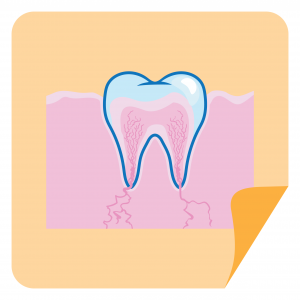
Procedures
Root Canal Treatment

A root canal involves the removal of the pulp and the replacement of the tissue with a biocompatible filling material.
During a root canal, a local anesthetic will be given to ensure the patient is comfortable. Next, a sheet called the “rubber dam” will be placed around the tooth to isolate it and keep it clean during treatment. The root canal procedure itself consists of three or four basic steps, but the number of visits will depend on the degree of infection/inflammation as well as the degree of treatment difficulty and patient’s time constraints.
As with any biologic treatment, there are no guarantees, however endodontic therapy enjoys a very high degree of success, often >90%. Dr. Massaro staff will discuss with you the chances of success before any endodontic procedure is initiated in order to help you make an informed decision.
Retreatment

Although rare, occasionally a tooth that has undergone root canal treatment fails to heal or pain continues despite adequate endodontic therapy. Luckily, this tooth can often be maintained with a second endodontic therapy, called retreatment. Again, local anesthetic is applied and rubber dam will be placed to isolate the tooth. Using endodontic solvents and instruments, the pre-existing filling materials are removed, the canals are re-sterilized and a new biocompatible filling material will be placed. Once again, success rates are very high for endodontic retreatment procedures, but Dr. Crista Massaro will be sure to discuss prognosis for each individual case prior to initiating treatment.
Often during retreatment, an existing crown post and core may need to be disassembled to gain access to the endodontic filling materials. Our office will be sure to communicate with our patients and referring doctors to determine if new restorative materials are indicated after endodontic treatment is completed.
Diagnose Cracks/Vertical Root Fractures

Oral pain such as toothaches or cracked / fractured teeth can often be difficult to pinpoint. Because of the vast network of nerves in the mouth, the pain of a damaged or diseased tooth often is felt in another tooth and/or in the head, neck, or ear. An endodontist is a specialist in diagnosing and treating this type of pain.
Traumatic Injuries

Pulp damage is sometimes caused by a blow to the mouth, and the endodontist specializes in treating these traumatic injuries. For example, a blow to a child’s permanent tooth that is not fully developed can cause the root to stop growing. A procedure called apexification stimulates bone to be deposited at the end of the root which makes it possible to then save the tooth through a root canal procedure. An endodontist is specially trained in procedures for replanting teeth that have been knocked out of their sockets.
Internal Bleaching

Internal, or non-vital, bleaching is used to lighten a darkly discolored tooth that has had root canal therapy. A chemical oxidizing agent is placed within the coronal portion of a tooth to remove tooth discoloration. It may be performed in the dental office using a procedure known as “chair-side bleach.” In this procedure, bleach crystals are placed inside the tooth, left for a period of time, and then removed before leaving the office. This may be done once or several times, depending upon the severity of discoloration of the tooth.
Pulp damage is sometimes caused by a blow to the mouth, and the endodontist specializes in treating these traumatic injuries. For example, a blow to a child’s permanent tooth that is not fully developed can cause the root to stop growing. A procedure called apexification stimulates bone to be deposited at the end of the root which makes it possible to then save the tooth through a root canal procedure. An endodontist is specially trained in procedures for replanting teeth that have been knocked out of their sockets.

